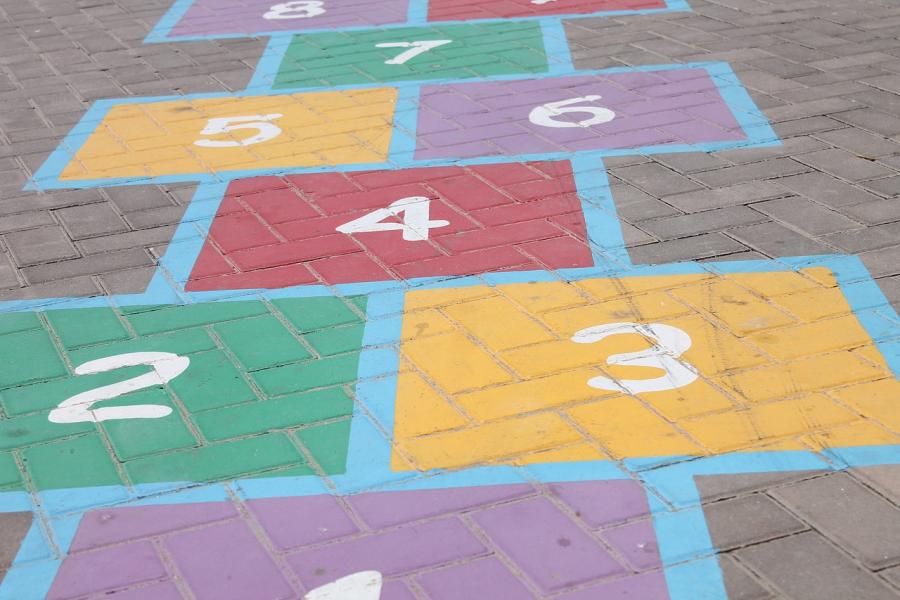Among the many positive traits and values of Filipinos, perhaps the most popular trait is being a sociable. Indeed, most Pinoys are friendly, cheerful, hospitable, and easy to talk to. This could be because since we were young, we learned how to make friends and how to interact with others through the games we play.
In this article, we shall take a trip back to memory lane and look back at the traditional games of our childhood. In addition, we will recall the 90s toys and games that filled our days… way before mobile phones and online platforms took over!
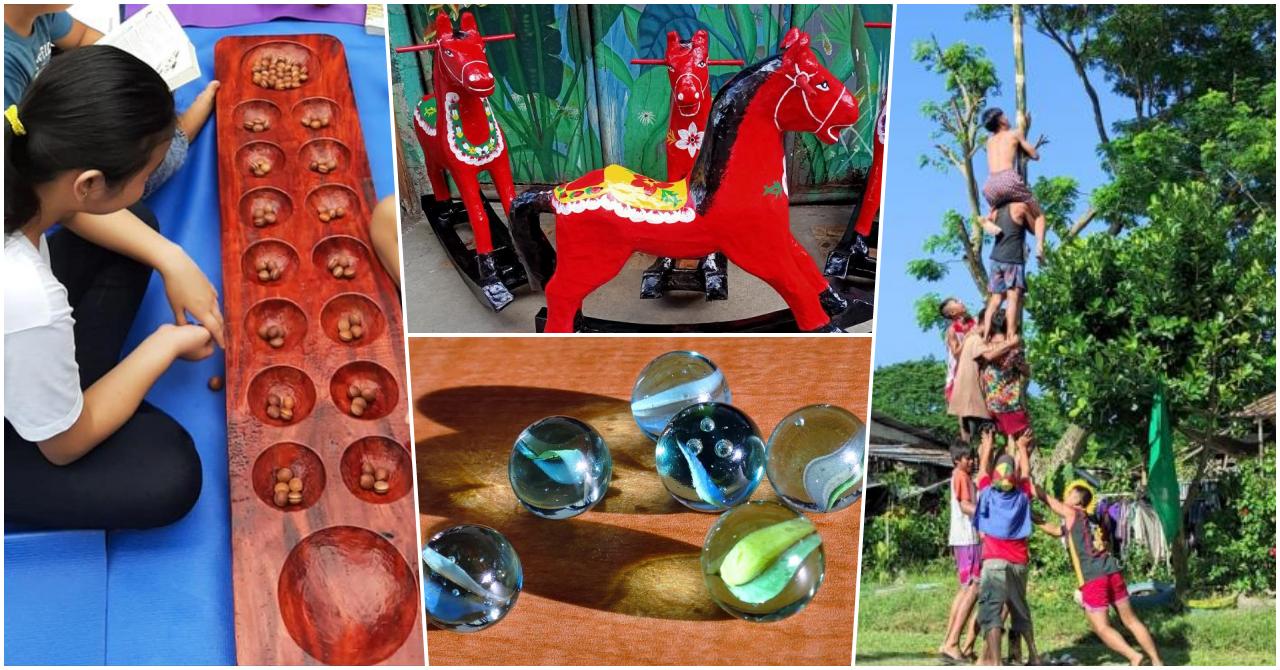
Best Traditional Pinoy Games
Before the era of mobile phones, online gaming, and social media, Filipino children played with local toys, native materials, and whatever could be easily found in their environment. You may still remember making necklaces out of sampaguita flowers, or taking care of “salagubang” (beetles) in tin cans as pets.
Back then, toys such as Barbie and LEGO were quite expensive, but Pinoy kids were perfectly happy outside — playing all sorts of games with their neighbors and friends. Meanwhile, during fiestas, many people — young and old alike — participated in “larong Pinoy” (Filipino games) that were truly exciting, indeed!
Here are some traditional Pinoy games, some of which remain popular to this day:
1. Bahay-Bahayan
Basically, this is a role playing game wherein children “pretend” to manage a home. It usually includes making a “bahay-bahayan” (makeshift house) from blankets, curtains, cardboard boxes, and other materials. In this house, they would “cook,” “clean,” and do other household activities. Each one had a role to play!
2. Lutu-Lutuan
“Lutu-lutuan” is usually played within the setting of “bahay-bahayan.” It is based on the word “luto,” which means “to cook.” Young Filipino girls would play with miniature cookware, including a mini “palayok” (clay pot). Flower petals, leaves, and other natural materials would serve as the “ingredients” for their dishes!
3. Baril-Barilan
While young girls loved to play bahay-bayahan and lutu-lutuan, most boys preferred “baril-barilan,” which — you guessed it — involved toy guns (baril) made from wood, plastic, and other materials. Thanks to the late Fernando Poe Jr. (FPJ) and his action movies, many Pinoy youngsters of yesteryear pretended to be cops and soldiers, toy guns in hand… going after bad guys!
4. Palosebo
“Palosebo” is a contest that’s often played during town fiestas, especially in the provinces. Players race to climb a greased bamboo pole, attempting to reach a small bag attached to the top. Obviously, the bag contains an exciting prize… money or toys. Sometimes, instead of a bag, there’s a flag at the top. But the objective is always the same — the first person to reach the top of the bamboo pole wins the prize!
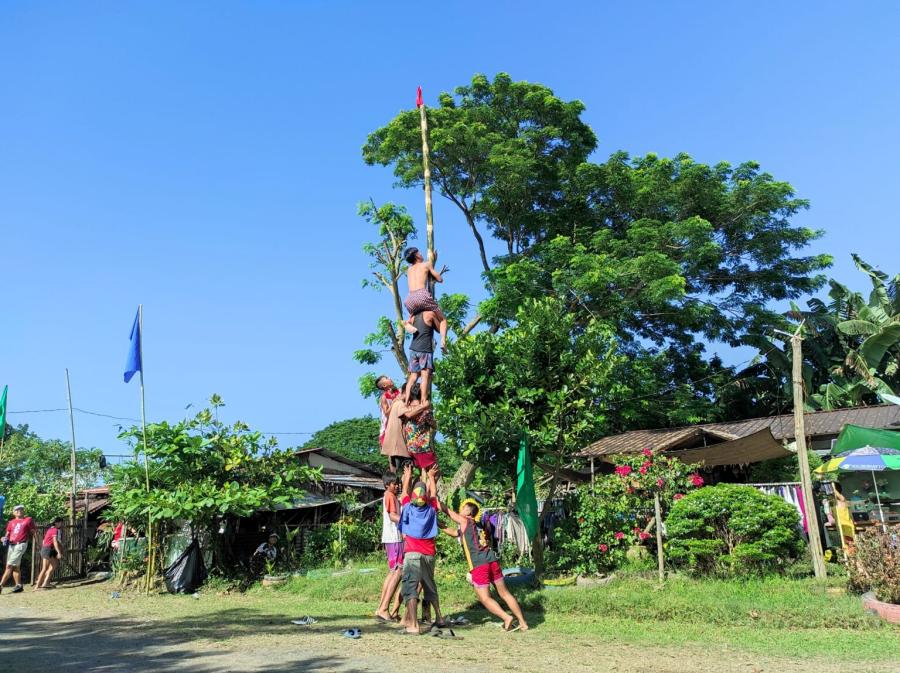
5. Langit Lupa
“Langit, lupa, impyerno… I-i-impyerno; Saksak puso, tulo ang dugo; Patay, buhay, Umalis ka na sa pwesto mo (Heaven, earth, hell… h-h-hell; Stabbed heart, dripping in blood; Dead, alive, get out of there)!”
As morbid as these words may sound, if you actually sang along, then you have probably played “Langit Lupa” as a kid. This is actually a modified “tag” game where everybody sings the above song. When the song is finished, everybody stops and one player (the “It”) starts to chase after the others. He/She may tag players who are on the ground/earth (“lupa”), but not those who are standing on higher ground/heaven (“langit”). Whoever gets tagged becomes the next “It.” Sounds exciting, right?!
6. Luksong Tinik
Ah, who can forget “luksong tinik”? Many Pinoy kids loved to play this in the school grounds during recess. Basically, two (2) kids are assigned as “tinik” (thorns), their legs on the ground while the other kids have to “lukso” (jump) over them. The “thorns” get higher and higher with each round — as the two kids place their legs, and eventually their arms, on top of the other.
The other players have to clear each round by jumping without touching the thorns. Those who fail to clear the jump become the next set of thorns, and the game starts all over again.
7. Luksong Baka
This game is a variation of the “luksong tinik.” Instead of jumping over thorns, however, players have to jump over an assigned “baka” (cow). The “cow” starts with a low crouch, standing higher and higher with each round. Other players have to clear each round by jumping over the cow. He/She who fails to clear the jump becomes the next cow. Exciting, right?!
8. Rocking Horse
The rocking horse is a toy that originated from Europe, way back in the 19th century. But did you know that we have a Philippine version? In particular, the town of Paete in Laguna province is known for creating beautiful wooden horses, as well as “taka” (paper mache) rocking horses. Notably, Paete’s rocking horses and other wooden toys remain popular to this day!
Other than toys, the town of Paete is also know for producing wooden furniture such as cabinets, beds, dining sets, sofas, chairs, and many more.
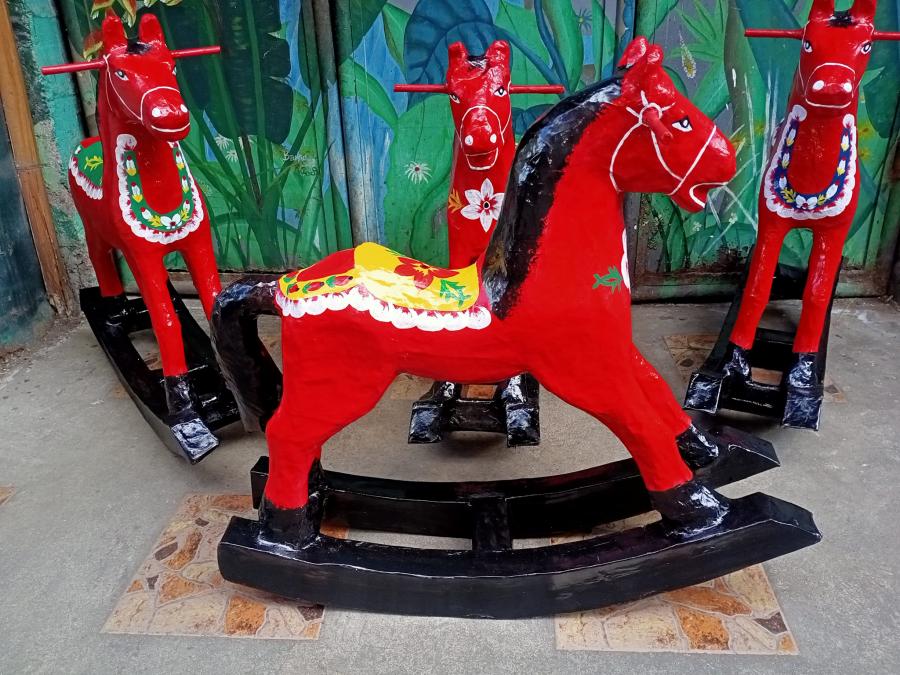
9. Pitik Bulag
This game is designed for two (2) players. One player covers his eyes with a hand — as if he were blind (or “bulag”). The other flicks (or “pitik”) a finger over the hand covering the eyes. Then, at the same, both players give a number using their other hands. If their numbers are the same, they exchange roles.
In another version, the player who is covering his eyes would try to guess the finger that the other player used to flick his hand. If he guesses right, they exchange roles. It’s a simple game, but also a really fun way to pass the time!
10. Sipa
The word “sipa” means “to kick,” and this is exactly what this game is all about. The object used in the game is also known as sipa, which was often made by tying plastic straws or candy wrappers onto a 5-centavo coin. Back then, this type of coin had a hole in the middle; this is where the plastic straw or candy wrappers were tied.
The rules of the game are simple: throw the sipa upwards, then “catch/kick” it — with your foot — again and again before it falls to the ground. You can also use your knees (bent upward) for catching the sipa. The player with the highest number of kicks wins the game!
11. Saranggola
The “saranggola” (kite) is a popular toy in many countries, including the Philippines. It is usually made from light materials and tied onto a very long piece of string. Trying to get the kite “to fly” is actually fun in itself. However, many kite-flyers usually make a game of it by trying to damage/bring down one another’s kites. The person whose kite falls to the ground loses!
Interestingly, if you go to the city of Sipalay in Negros Occidental province, they hold a “Kite Festival” every year. This festival holds kite-flying competitions for various categories: Flat Kites, Barungoy or Flying Fish Kites, Figure Kites, and 3D Geometric Kites. No wonder this city is known as the “Kite Tourism Capital” of the Philippines!
12. Trumpo
The “trumpo” (spinning top) is another popular toy in the Philippines. A length of string is wound around the top; it is then launched onto a flat surface, where it spins. When two (2) or more kids play this game, they let their tops spin and hit each other. The player with the last top spinning is declared the winner.
13. Tsato
“Tsato” is also known as “syato” or “shatong” and is usually played in the provinces. There are at least two (2) players, and two sticks — a long stick, and a short one. The short stick is placed in a small hole on the ground. Then, using the long stick, players take turns in overthrowing the small stick on the ground. The farther the small stick “flies,” the higher the score.
14. Tumbang Preso
“Tumbang preso” is a popular street game in the Philippines. It is sometimes called “tumba lata” since it makes use of a “lata” (tin can). This game is best done if there are many players. One players is assigned as the “taya” (or “It”); his role is to guard the tin can. The other players attempt to hit the can using a “pamato” (usually their slippers) one by one. As soon as a player hits the can, everybody grabs their slippers and runs — since the “It” would start chasing after them. The player who gets caught becomes the new “It” who would guard the tin can.
15. Sungka
“Sungka” is a strategy board game played by two (2) persons. Each person is assigned seven cups on the sungka board — six cups for holding small shells (or small pebbles or dried tamarind seeds) and one cup to serve as his/her home base. The players take turns, picking shells from cups and distributing these across the board.
Once all the shells have been distributed and collected, the players count the shells in their home bases. The player with the higher number of shells in his/her home base wins.
Interestingly, versions of “sungka” are also played in neighboring countries of the Philippines. In Brunei and Malaysia, the game is called “congkak,” while in Indonesia, it goes by several names — “congklak,” “congkak,” “congka,” and “dakon.” Notice that even the names sound very similar!
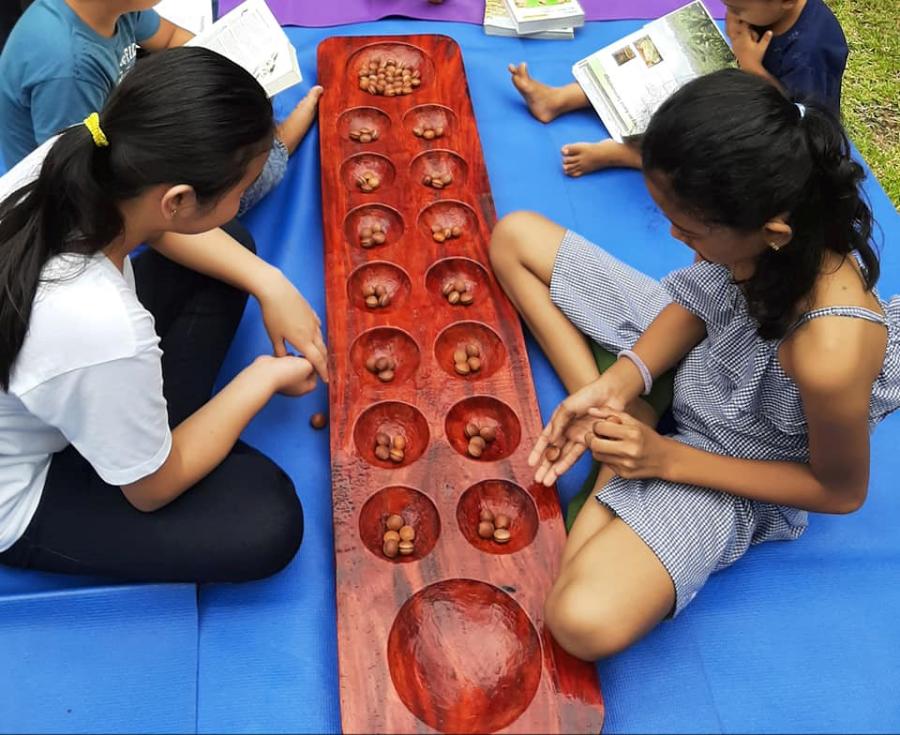
‘90s Larong Pinoy
So far, we have talked about traditional Filipino games that have been around for a very long time, many decades ago. This time, we will focus on games that became extremely popular during the 1990s. If you’re a ‘90s kid, you will surely recognize the following games:
1. Chinese Garter
Usually played by young girls, Chinese garter involves a long piece of garter, or an elastic string comprised of connected rubber bands. It involves two (2) or more players. Two of the girls each hold one end of the garter. Meanwhile, the other girl(s) attempts to jump over the garter, which is raised higher and higher after each round. By the time it reaches shoulder-height or head-height; instead of jumping, the girls can do cartwheels to try and go over the garter.
2. Ten-Twenty
This is another “garter” game played by Filipino girls of the ‘90s. It involves at least two (2) pairs of players, who take turns holding the garter and jumping on it. The game is called “ten-twenty” as these are the first words uttered in the “routine” that accompanies each round.
Interestingly, the routine involves 10 steps, each of which is performed while chanting the numbers “ten, twenty, thirty, forty, fifty” and so forth… until “one hundred.” Similar to the first game, the garter is raised higher and higher after each round.
3. Jak en Poy
“Jak en Poy, hale-hale-hoy; Sino’ng matalo s’yang unggoy (Jack and Poy, hale-hale hoy; Whoever loses is a monkey!)” These are the words chanted by the players of this game, which is similar to the “rock, paper, scissors” game in the United States. Depending on how many rounds are played, the player with the highest number of “wins” is the declared the champion.
4. Kisses
During the 1990s, aroma beads, which were called “kisses,” became very popular. Many young girls started collecting these in boxes, sometimes in their pencil cases! Many of them also believed that these kisses would multiply if placed in a moist (e.g. wet cotton) environment. However, this was not actually true and the belief that kisses could multiply was merely an urban legend. Still, this didn’t stop many Filipino kids from collecting these multicolored beads!
5. Nanay, Tatay
“Nanay, Tatay” is a hand clapping game that can be played by two (2) or more players. The idea is to complete a clapping routine — without any mistakes — while singing a song. The song usually goes like this:
“Nanay, Tatay, gusto ko’ng tinapay; Ate, Kuya, gusto ko’ng kape; Lahat ng gusto ko ay susundin niyo; Sino’ng sasali sa laro’ng ito? Ang magkamali ay pipingutin ko (Mother, Father, I want bread; Sister, Brother, I want coffee; Follow all that I say; Who will join this game? Whoever makes a mistake, I will pinch your ears)!”
Sounds really catchy, right?! Aside from “Nanay, Tatay” other versions of this game involve the nursery rhymes “Bahay Kubo” and “Leron Leron Sinta.”
6. Paper Dolls
Who needs Barbie when you can have a Sailor Moon or Princess Sarah paper doll? During the 1990s, paper doll kits featuring famous characters of the time were really popular. These kits usually came with a wide variety paper clothes (e.g. dresses, gowns, suits), and paper accessories (e.g. hats, bags) as well. They were easy to carry, affordable, and really fun to play with!
7. Holen
Did you know that the term “holen” actually comes from the English phrase “hole in?” That’s right! This game is played using marbles, which are called “holen” in the Philippines to this day. Two (2) or more players can join this game. Each player takes turns, flicking a marble towards a group of marbles inside a circle. The marbles that get hit outside the circle becomes his. Whoever collects the highest number of marbles is declared the winner of the game.
8. Patintero
This game is usually played on the street by two (2) groups of multiple players. One group serves as the “bantays” (guards), who can only move along “lines” on the street (usually drawn with chalk). Meanwhile, members of the other group try to cross these lines without getting tagged or caught by the bantays. “Patintero” is truly an exciting game; even adults can play it, too!
9. Plastic Balloon
In the ‘90s, a popular product called “plastic balloon” came out. Each pack contained a straw, and a tiny tube of sticky substance, which, when rolled properly and blown into using the straw — produces balloons. It takes a lot of practice to create the biggest and strongest balloons. Young kids would often compare who made the best ones.
10. Sawsaw Suka
“Sawsaw suka, mahuli taya (Dip into vinegar, whoever gets caught is It)!” is the song that usually accompanies this game. One player opens his palm, and the other player “dips” his fingers repeatedly onto the palm while everyone chants the song. When the song is finished, the first player tries to catch the second player’s finger with his palm. If he succeeds, the second player becomes the “It” and starts chasing everybody! As you can see, this game can be used to choose an “It” for any game!
11. Taguan
“Tagu-taguan, maliwanag ang buwan; Masarap maglaro sa dilim-diliman; Pagkabilang ko’ng sampu, nakatago na kayo; Isa, dalawa, tatlo… sampu (Hide and seek, the moon is bright; It’s fun to play in the semi-dark night; When I finish counting to ten, all of you should be hidden; One, two, three… ten)!”
This song is usually chanted in the game of “taguan,” which is the counterpart of “hide and seek” in the United States. It is usually played at dusk or during moonlit evenings. The “It” is the one who chants the song; after counting to ten, he/she begins looking for everyone. The first person he/she catches becomes the next “It.”
12. Piko
“Piko” is actually the Pinoy version of hopscotch. A set of boxes are drawn onto the ground, with each box requiring a one-leg or two-leg jump. The game also involves a “pamato” (cue ball/item), which could be a stone, bottlecap, slipper, or other items.
13. Takip-Silim
This game is a variation of “taguan” (or hide and seek). One player, the “It” is blindfolded; he counts from one to ten while the other players hide. As soon as the “It” finds a hidden player, he needs to guess who it is. If he guesses correctly, the player who got caught becomes the new “It.”
14. Teks
“Teks” are basically game cards that Filipino children used to collect in the 1990s. The game is played by flicking cards into their air until they hit the ground. Depending on how the cards are laid on the ground ( players bet on which side a betting card faces) — the winner gets to collect the other players’ cards.
What’s really interesting about Teks cards is they usually feature a popular character, TV show, or movie. If you’re a ‘90s kids, then you should definitely know these common Teks characters/shows: Dragon Ball Z, Ghost Fighter, Marimar, Sailor Moon, Zenki, and many more.
15. Pogs
“Pogs” is actually quite similar to Teks, except for the shape of the card. Pogs cards are circular, whereas Teks cards are rectangular in shape. Similar to Teks, after much flicking, tossing, and slamming — the person who collects the highest number of Pogs cards wins.
Amazingly, the term “Pogs” is said to have come from a brand of juice, which was known as “POG” — an acronym for passion fruit, orange, and guava (the flavors of the drink). In an earlier version of the game, the bottle caps of POG drinks were used for playing. Eventually, the name stuck, and it was used to call the circular cards game.
Summary
Looking back, you can imagine how much fun Filipino children had back then, playing all sorts of games — both inside and outside the house! Nowadays, many ‘90s children have kids of their own, but the scenario is different now. Instead of paper dolls, marbles, and rocking horses, today’s kids are more likely to ask for a smart phone or a tablet. And rather than play outside, they are more excited to play virtual games instead.
Perhaps now, more than ever, there is a need to go revive traditional Filipino games. If you are a parent, or if you interact with kids a lot, be sure to introduce them to the games above. Who knows? They just might enjoy “Jak en Poy,” “Ten-Twenty” or “sungka.” They are kids, after all… and kids should enjoy playing physical games!
Aside from Larong Pinoy, another thing worth introducing to today’s kids are “slam books” — you know… those notebooks we used to pass around in school when we were young? To get a better idea, check out this list of the best slam book questions to ask your friends!



